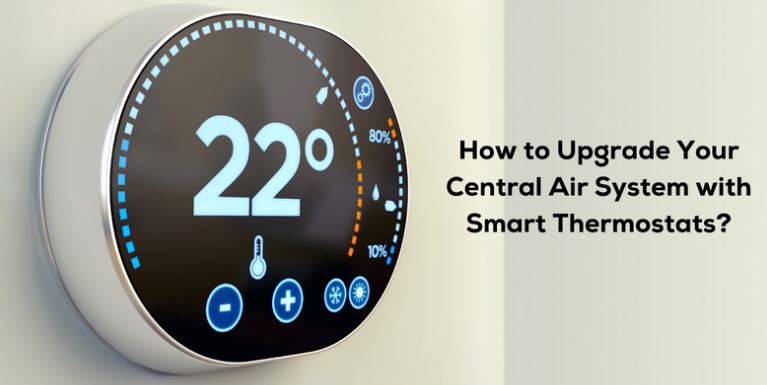Is your home’s central air system beginning to show signs of aging? Smart home technology keeps advancing. Therefore, upgrading to a smart thermostat can significantly enhance efficiency, convenience, and connectivity. This guide will delve into the following topics:
-
Key benefits of smart thermostats for central air conditioning
-
What to consider before upgrading
-
Advanced features that enhance the user experience
-
How these innovative devices contribute to sustainability?
Read on to determine if upgrading to a smart thermostat is suitable for your home.
Why Upgrade to Smart Thermostats?
Upgrade to a smart thermostat for your home’s HVAC system. It provides numerous practical and cost-saving advantages. Specifically, smart thermostats use the following to optimize energy usage:
-
IoT connectivity
-
Smart learning algorithms
-
Automation
It provides homeowners with more precise control over temperature schedules. According to Energy Star, certified smart thermostat models can help households save. It can go up a yearly average of 8% on HVAC electricity costs. This amounts to $131 in annual savings for heating and $145 in annual savings for cooling. Beyond tangible cost savings, these devices also offer features like:
-
Remote access from smartphones/tablets
-
Seamless integration with voice assistants like Alexa and Google Home
-
Intuitive control interfaces
-
Real-time insights about your HVAC system performance
For most homeowners, upgrading provides the ideal blend of efficiency, convenience, and connectivity. Residential air conditioning installation empowers them to truly transform the climate management experience. If they find any difficulty during the process, they can call an HVAC company for professional assistance.
Key Features and Benefits
Upgrade your older conventional thermostat with a modern, connected model. It has some significant benefits. Here are the most impactful features and capabilities modern smart thermostats provide:
Energy Efficiency and Cost Savings
Smart thermostats aim to cut energy consumption while maintaining comfort. Energy Star-certified models save an average of 8% on heating and cooling costs, delivering $50 or more in annual savings. These devices fine-tune your system’s operation to minimize waste. It is accomplished through connected technology and automation.
Learning Capabilities and Automation
One of the hallmarks of smart technology is the ability to learn household patterns and adjust them automatically. Smart thermostats detect occupancy and build schedules around your routine. Thus, temperatures at home suit your lifestyle. This means avoiding heating or cooling an empty home, saving energy in the process.
Remote Monitoring and Control
Tired of dashing home to adjust your thermostat? Smart models allow remote temperature adjustments from your smartphone, tablet, or laptop. They offer you the ultimate convenience. Wherever you connect to Wi-Fi, you stay in control of your home’s ideal temperature. This makes life easier while saving energy as well.
Integration with Smart Home Ecosystems
For advanced smart home control, many smart thermostats integrate with platforms like:
-
Amazon Alexa
-
Google Assistant
-
Apple HomeKit
The Energy Star program notes how their certified thermostats can enter a low-power standby mode when inactive. They save even more energy when they are part of a connected ecosystem. This allows for heating and cooling automation based on various triggers.
What to Consider Before Upgrading
Smart thermostats promise enticing benefits. Here are a few key considerations when preparing to upgrade your central air system:
Ensuring Compatibility
According to the U.S. Department of Energy, smart thermostats are compatible with most forced HVAC systems installed after 1975. However, some advanced systems may need special guidance. Examples of this are variable speed setups, multistage configurations, or zoned layouts. Consult with an HVAC professional to verify full compatibility before purchasing.
Wi-Fi and Mobile Requirements
These connected devices rely on Wi-Fi to enable remote access and automation. Your home internet connection must offer reliable Wi-Fi coverage. That way, you can fully utilize the smart capabilities, notes Digital Trends. You’ll also need a compatible smart device like a smartphone or tablet to control settings on the go.
Installation Needs
Depending on the specifics of your HVAC system and your DIY comfort level, you may opt for professional installation. You can also take on the project yourself. According to Energy Star, the process typically involves the following:
-
Disconnecting wires
-
Securing connections
-
Some initial configuration
For complex existing setups, experts help ease the transition to smart technology.
Advanced Features for an Upgraded Experience
Once the smart thermostat is installed and connected, an array of advanced features becomes available. It is perfect for an upgraded home climate control experience:
Location-Based Heating and Cooling
Smart thermostats use a feature called geofencing. It triggers temperature changes based on the location of household members, notes Energy Star. Through connected smartphones that come and go, your system automatically heats or cools less when no one is home to save energy.
Energy Usage Insights & Reporting
Wonder just how much energy your home HVAC system uses? Smart thermostats provide detailed reporting on certain factors for increased efficiency:
-
Runtime hours
-
Temperature trends over time
-
Opportunities for increased efficiency
These usage insights, as Energy Star indicates, allow consumers to tweak settings for improved energy and cost savings.
Intuitive and Attractive Interfaces
Old-school thermostats usually have hard-to-read displays. However, smart models invest heavily in their user interface. They offer intuitive controls and eye-catching visual designs. According to Digital Trends, the user-friendly interface and modern design enhance the overall user experience. Adjusting temperatures or schedules becomes almost enjoyable!
Supporting Sustainability
Smart thermostats go beyond convenience and connectivity. These innovative devices also support broader sustainability initiatives aligned with environmental responsibility. As explained by Energy Star, optimized efficiency directly reduces energy waste in homes. In effect, it lowers greenhouse gas emissions associated with power generation. Homes that upgrade to Energy Star appliances contribute to reducing the collective carbon footprint.
Frequently Asked Questions
Do smart thermostats work with all types of HVAC systems?
Smart thermostats are compatible with most forced air systems. However, some advanced configurations should be verified with an HVAC professional before purchasing. HVAC.com notes systems with add-ons like zone dampers may require special thermostats.
Can I install a smart thermostat myself, or do I need to hire help?
According to the Smart Thermostat Guide, the installation process is complex on an intermediate level. This involves disconnecting existing wires and reconnecting to a smart model. Those familiar with basic electrical work can likely DIY. Meanwhile, novice homeowners may benefit more from professional support.
How much money can smart thermostats save on energy?
Numerous credible sources emphasize average savings of 8-10% on heating and cooling expenses. This occurred after upgrading to a smart thermostat, as noted by Hillside HVAC. This amounts to $40-$50 in savings per year. Larger homes that use more energy may save even more on annual bills.
Key Takeaways on Upgrading to Smart Thermostats
-
Smart thermostats use automation and connectivity to optimize energy efficiency. It saves homeowners approximately 8% on their electricity costs.
-
Consider compatibility, Wi-Fi coverage, installation complexity, and mobile device requirements. If everything is satisfactory, proceed to upgrade your central air system.
-
Advanced features like geofencing, energy insights, and intuitive controls enhance the user experience.
-
Beyond convenience and efficiency, smart thermostats also support environmental sustainability. They do this through reduced energy waste.
Smart home technology continues to mature. Smart thermostats make an excellent first upgrade to save money and gain control. It can also reduce your environmental impact. The thought of replacing your old thermostat might seem daunting, but the potential benefits make it a worthy consideration.



